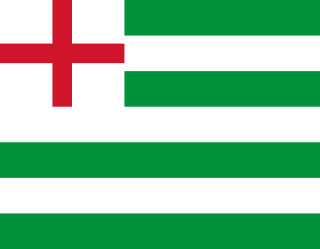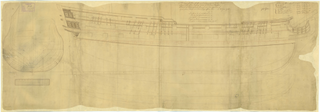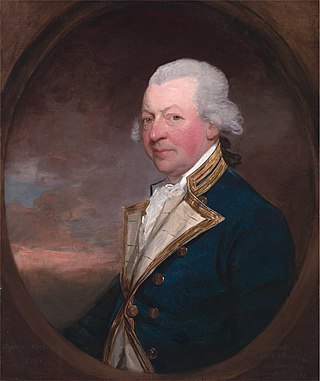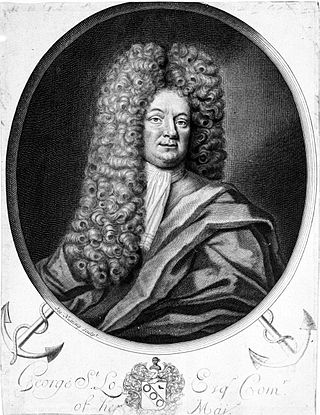
The Treasurer of the Navy, originally called Treasurer of Marine Causes or Paymaster of the Navy, was a civilian officer of the Royal Navy, one of the principal commissioners of the Navy Board responsible for naval finance from 1524 to 1832. The treasurer was based at the Navy Pay Office.
Admiral Sir John Ashby was an officer of the Royal Navy, who rose to the rank of Admiral. Ashby was the fourth son of Robert Ashby and his wife Alice, who was a sister of Sir Thomas Allin. He grew up in Suffolk where his father was involved in business.

Admiral George Carnegie, 6th Earl of Northesk was a Scottish naval officer and peer. He was the son of David Carnegie, 4th Earl of Northesk and Lady Margaret Wemyss and was born on 2 August 1716. A career Royal Navy officer, he fought in the War of the Austrian Succession and the First Carnatic War, where in the East Indies he participated in the action of 6 July 1746. His service was curtailed by a series of debilitating illnesses and he never served at sea again after being promoted to rear-admiral in 1756. He died on 20 January 1792 at age 75.

Admiral Sir William Wynter held the office of Surveyor and Rigger of the Navy for 40 years, from 1549 until his death in 1589, and combined that with the office of Master of Navy Ordnance from 1557. He was an admiral and principal officer of the Council of the Marine under Queen Elizabeth I of England and served the crown during the Anglo-Spanish War (1585–1604). He was returned four times to parliament in Elizabeth's time.

The Tudor navy was the navy of the Kingdom of England under the ruling Tudor dynasty (1485–1603). The period involved important and critical changes that led to the establishment of a permanent navy and laid the foundations for the future Royal Navy.

The East Indies Station was a formation and command of the British Royal Navy. Created in 1744 by the Admiralty, it was under the command of the Commander-in-Chief, East Indies.

HMS Orford was a 70-gun third rate ship of the line of the Royal Navy, built to the draught specified by the 1745 Establishment at Woolwich Dockyard, and launched in 1749.

John MacBride was a British officer of the Royal Navy and a politician who saw service during the Seven Years' War, the American War of Independence and the French Revolutionary Wars, eventually rising to the rank of Admiral of the Blue.

The First Lord of the Admiralty, or formally the Office of the First Lord of the Admiralty, was the political head of the English and later British Royal Navy. He was the government's senior adviser on all naval affairs, responsible for the direction and control of the Admiralty, and also of general administration of the Naval Service of the Kingdom of England, Great Britain in the 18th century, and then the United Kingdom, including the Royal Navy, the Royal Marines, and other services. It was one of the earliest known permanent government posts. Apart from being the political head of the Naval Service the post holder was simultaneously the pre-eminent member of the Board of Admiralty. The office of First Lord of the Admiralty existed from 1628 until it was abolished when the Admiralty, Air Ministry, Ministry of Defence and War Office were all merged to form the new Ministry of Defence in 1964. Its modern-day equivalent is the Secretary of State for Defence.
Sir John Clere was an English politician and naval commander.

George St Lo was a British naval officer and politician.

The Admiralty and Marine Affairs Office (1546–1707), previously known as the Admiralty Office (1414–1546), was a government department of the Kingdom of England, responsible for the Royal Navy. First established in 1414 when the offices of the separate Admiral of the North and West were abolished and their functions unified under a single centralised command, it was headed by the Lord High Admiral of England. The department existed until 1707 when England and Scotland united to form the Kingdom of Great Britain, after which it was known as the British Admiralty.
The Downs Station also known as the Commander-in-Chief, the Downs or Admiral Commanding at the Downs was a formation of the Kingdom of Great Britain and then the United Kingdom's Royal Navy based at Deal. It was a major command of the Royal Navy from 1626 until 1834.

The Commander-in-Chief, North Sea, was senior appointment and an operational command of the British Royal Navy originally based at Great Yarmouth from 1745 to 1802 then at Ramsgate from 1803 until 1815.
The Commander-in-Chief, English Channel or formally Commander-in-Chief, of His Majesty's Ships in the Channel was a senior commander of the Royal Navy. The Spithead Station was a name given to the units, establishments, and staff operating under the post from 1709 to 1746. Following Admiral Lord Anson new appointment as Commander-in-Chief, English Channel this office was amalgamated with the office of Commander-in-Chief, Portsmouth.
Admiral Sir John Malyn or Malen, was a seaman, shipowner and later senior officer of the English Navy Royal who served under Henry VIII, Edward VI and Mary I. He died at sea off the coast of Rye, East Sussex, England whilst in command of his ship HMS Grehound that was wrecked after hitting an unseen sandbar.

The North Sea Squadron was a temporary naval formation of the Tudor Navy Royal during the sixteenth century operating out of Newcastle, England.

The Channel Squadron also referred to as the Western Squadron (1512-1649) was a series of temporary naval formations first formed in under the English Tudor Navy Royal during the sixteenth century. Later during the Interregnum a channel squadron was formed as part of the Commonwealth Navy. During the 18th century as part of the Royal Navy.

The official history of the Royal Navy began with the establishment of the Navy Royal by Henry VIII in 1546. The modern incarnation of the institution re-emerged as the national naval force of the Kingdom of England in 1660, following the Restoration of King Charles II to the throne. However, for more than a thousand years before that there had been English naval forces varying in type and organisation. In 1707 it became the naval force of the Kingdom of Great Britain after the Union between England and Scotland which merged the English navy with the much smaller Royal Scots Navy, although the two had begun operating together from the time of the Union of the Crowns in 1603.
Rear-Admiral George Murray, 6th Lord Elibank was a British naval officer. He joined the Royal Navy in the early 1720s and fought in the Battle of Porto Bello in 1739 as a lieutenant on board the ship of the line HMS Hampton Court. Murray was promoted to commander in 1740 and given command of the sloop HMS Tryall to take part in George Anson's voyage around the world. A series of illnesses and deaths in Anson's squadron meant that by early 1741 Murray had been promoted to post captain and given command of the frigate HMS Pearl. Pearl and another ship lost contact with Anson in April of that year and after taking heavy damage and casualties through storms and sickness, sought safety in Rio de Janeiro before sailing for England.












